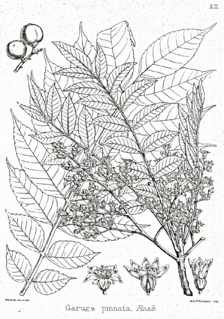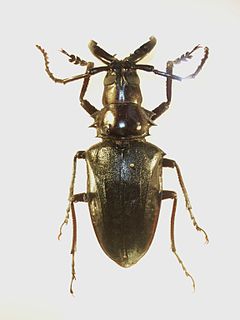
Magnolia is a large genus of about 210 to 340 flowering plant species in the subfamily Magnolioideae of the family Magnoliaceae. It is named after French botanist Pierre Magnol.

The common moorhen, also known as the waterhen or swamp chicken, is a bird species in the rail family (Rallidae). It is distributed across many parts of the Old World.
Ulmus gausseniiW. C. Cheng, the Anhui, or hairy, elm, is a medium size deciduous tree whose natural range is restricted to the valleys of the Langya limestone mountains of Chu Xian in Anhui Province, eastern China. The tree was most commonly found on the flood plains, indicating a tolerance of periodic inundation. However, U. gaussenii is now possibly the rarest and most endangered elm species, with only approximately 30 trees known to survive in the wild in 2009. The tree was introduced to the West in 1995, at the Morton Arboretum, Illinois, as part of an evaluation of Chinese elms for landscape use.

Functional extinction is the extinction of a species or other taxon such that:
- It disappears from the fossil record, or historic reports of its existence cease;
- The reduced population no longer plays a significant role in ecosystem function; or
- The population is no longer viable. There are no individuals able to reproduce, or the small population of breeding individuals will not be able to sustain itself due to inbreeding depression and genetic drift, which leads to a loss of fitness.

Huaxiapterus is a genus of tapejarid pterodactyloid pterosaur from the Aptian-age Lower Cretaceous Jiufotang Formation of Chaoyang, Liaoning, China. It is the second genus of tapejarid from this formation, after Sinopterus. Three species are known, though they may not actually form a natural group with each other. It was first named by Lü Junchang and Yuan Chongxi.

Scaphium affine is a tree species in the family Malvaceae, subfamily Sterculioideae. It is native to mainland Southeast Asia and no subspecies are listed in the Catalogue of Life.

A species that is extinct in the wild (EW) is one that has been categorized by the International Union for Conservation of Nature as known only by living members kept in captivity or as a naturalized population outside its historic range due to massive habitat loss.

Linnaea is a plant genus in the honeysuckle family Caprifoliaceae. Until 2013, the genus included a single species, Linnaea borealis. In 2013, on the basis of molecular phylogenetic evidence, the genus was expanded to include species formerly placed in Abelia, Diabelia, Dipelta, Kolkwitzia and Vesalea. However, this is rejected by the majority of subsequent scientific literature and flora.

The bronze sprite, also known as the black-gilded pipistrelle, is a species of vesper bat found in China, India, Myanmar, and Nepal.

The Yunnan hare is a medium-sized species of mammal in the family Leporidae. It has soft, flat, and long dorsal pelage which is grayish brown or dark gray in color, and whitish ventral pelage. It was considered endemic to China, but its presence was recorded in northern Myanmar in 2000. It is a herbivore, and forages on shrubs and forbs. It is rated as a species of least concern on the International Union for Conservation of Nature Red List of Endangered Species. The Red List of China's Vertebrates has listed the Yunnan hare as near threatened, almost meeting the criteria to be listed as vulnerable.

Dorysthenes buqueti, the sugarcane longhorn stemborer, is a species of longhorn beetles of the subfamily Prioninae.

Dorysthenes is a genus of longhorn beetles of the subfamily Prioninae.

Lasaeola is a genus of comb-footed spiders that was first described by Eugène Louis Simon in 1881. The type species was described under the name Pachydactylus pronus, but was renamed Lasaeola prona when it was discovered that the name "Pachydactylus" was preoccupied. Both this genus and Deliana were removed from the synonymy of Dipoena in 1988, but many of these species require more study before their placement is certain.
Dorysthenes dentipes is a species of beetle from the long horned-beetle family Cerambycidae. It is found throughout Vietnam, China, and Laos. The beetles can grow up to 46 millimeters long. The scientific name of the species was first published in 1902 by Faimraire.

Garuga pinnata is a deciduous tree species from the family Burseraceae.
Ficus simplicissima is an Asian species of fig tree in the family Moraceae. This species is similar to Ficus triloba and synonyms include Ficus hirta; its native range is Nepal to southern China and Indo-China, Sumatra and Java.

Dorysthenes walkeri is a species of longhorn beetles in the subfamily Prioninae. Records of occurrence are from Iran to Indo-China.
Helicia nilagirica is a tree of the Proteaceae family. It grows from Thailand across Mainland Southeast Asia to Yunnan, Zhōngguó/China and over to Nepal. It is a source of wood, a pioneer reafforestation taxa, and an ethnomedicinal plant.











